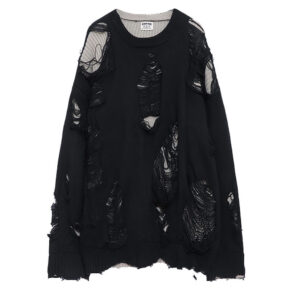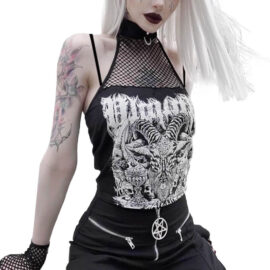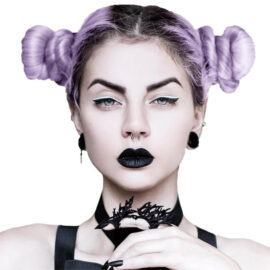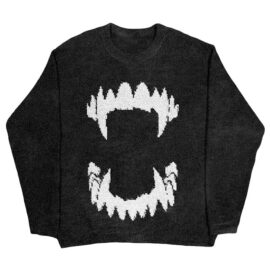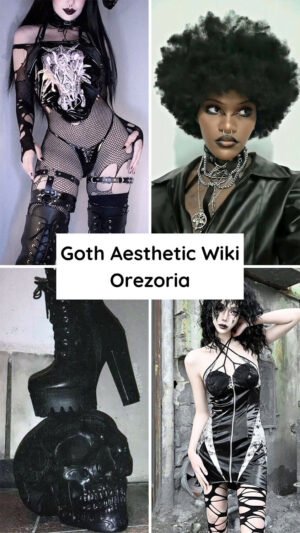
The Goth aesthetic, born from the depths of the post-punk scene in the late 70s and early 80s, is a mesmerizing blend of darkness and mystery. With its brooding elements and obsession with gothic-themed music, literature, and movies, it casts an irresistible spell on those who dare to embrace its allure.
Drawing inspiration from a variety of sources, the Goth aesthetic incorporates elements of Victorian and Edwardian fashion, as well as a sense of romanticism and darkness. The color black dominates in Goth fashion, symbolizing both a rejection of societal norms and an embrace of darker themes.
Music is an integral part of the Goth aesthetic, with genres such as gothic rock, ethereal wave, and industrial playing a prominent role. Bands like Joy Division, Bauhaus, and Siouxsie and the Banshees have heavily influenced both the fashion and lifestyle associated with the Goth aesthetic.
Literature also plays a significant role in shaping the Goth aesthetic, with works by authors like Edgar Allan Poe serving as a source of inspiration. Gothic literature’s emphasis on mood, atmosphere, and the exploration of darker themes has strongly influenced the style and mindset of those who identify with the Goth aesthetic.
Movies and films, particularly those with gothic themes, have also contributed to the development of the Goth aesthetic. From classic horror films to contemporary dark fantasies, visual storytelling has further cemented the visual elements and motifs associated with the Goth aesthetic.
Related aesthetics: Addamscore, Alternative, Cyberpunk, Dark Academia, Dark Fashion, Doomer, Dullcore, E-Girl, E-Boy, Edgy, Emo, Goblincore, J-Rock, Mallgoth, Pastel Goth, Punk, Soft Goth, Vampire, Visual Kei, Witchcore, Witchy Academia
Full List of Aesthetics
The History of Goth Aesthetic
The Mystic of the Goth aesthetic originated in the late 1970s and early 1980s as a subculture of the punk aesthetic and it’s harsh and rebellious vibes. It was influenced by gothic rock music, horror films, and gothic fiction, resulting in the development of its own distinct style and sensibility.
Originating from the punk subculture, the Goth aesthetic drew inspiration from the dark and brooding themes explored in gothic literature and the atmospheric sounds of bands like Joy Division, Bauhaus, and Siouxsie and the Banshees. This fusion of punk energy with a more melancholic and introspective approach set the stage for the emergence of a new subculture within the already alternative music scene.
Horror films, particularly those with gothic themes, also played a significant role in shaping the aesthetic. From classic black-and-white horror movies to contemporary dark fantasies, the visual storytelling and haunting imagery provided further inspiration for Goths in terms of fashion, makeup, and artistic expression.
Gothic fiction, with its emphasis on gloomy settings, mysterious characters, and macabre themes, further fueled the development of the Goth aesthetic. Works by authors like Edgar Allan Poe, with his dark and mysterious narratives, became a source of inspiration for Goths seeking a deeper exploration of the dark and romantic side of life.
As the Goth aesthetic evolved, it became more than just a fashion style, encapsulating a mindset and cultural movement that continues to thrive and inspire people today.
Types of Goth Sub Styles and Related Aesthetics
The Goth subculture is a diverse and ever-evolving entity, encompassing a wide range of substyles and related aesthetics. Each substyle represents a unique expression within the larger Goth culture, embracing different influences and fashion sensibilities.
From the traditional and romantic allure of the Victorian-inspired Trad Goth to the futuristic and edgy vibes of Cyber Goths, there is a substyle for every Goth enthusiast. In recent years, new aesthetics have emerged, such as the pastel and playful Pastel Goth and the athletic and minimalistic Health Goth. These substyles not only showcase the diversity within the Goth community but also reflect the ever-changing nature of fashion and personal expression.
Traditional (or Trad) Goth
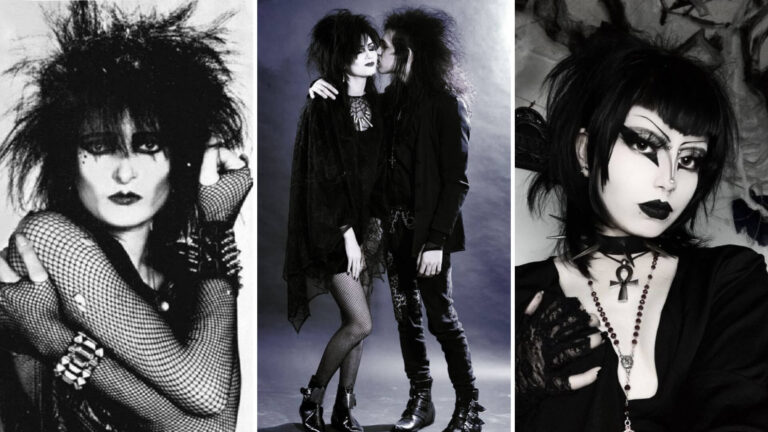
Traditional Goth, also known as Trad Goth, is a subculture that emerged in the 1980s and drew influences from rock and punk styles of the time. This subculture is characterized by its dark and somber aesthetic, embracing a meticulously crafted gothic fashion.
The origins of Traditional Goth can be traced back to the music scenes of the late 1970s and early 1980s, particularly the post-punk and gothic rock movements. Bands such as Joy Division and Bauhaus played a key role in shaping the goth sound and style, incorporating elements of melancholy and introspection into their music.
In terms of fashion, Traditional Goths often exhibit distinct features. They typically have pale skin and black hair, and their attire consists of dark clothes and accessories. Ripped fishnet stockings, grommet belts, leather boots, and metal accessories are commonly seen in Traditional Goth fashion. Dark and dramatic makeup, including smoky eye makeup and heavy eyeliner, are also characteristic of this subculture.
Gothcore
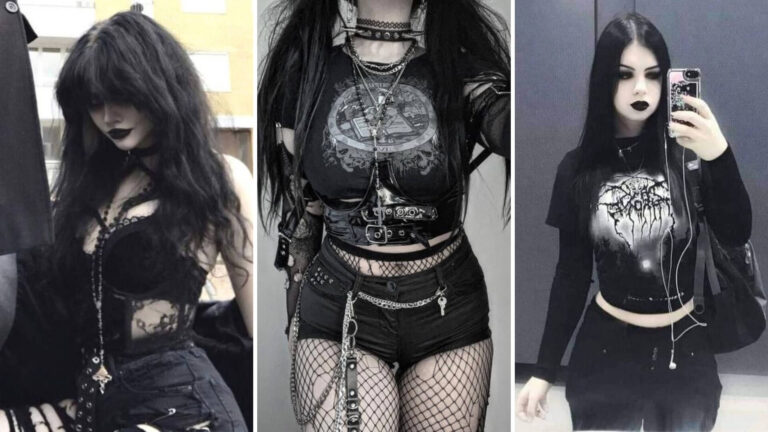
Gothcore is a subgenre and fusion of goth and hardcore punk music, fashion, and attitude. It is a distinctly dark and edgy aesthetic that combines the introspective and melancholic elements of goth with the abrasive and aggressive sound of hardcore punk.
In terms of fashion, gothcore takes inspiration from both goth and punk styles. It features a predominantly black color palette and incorporates elements such as leather jackets, spikes, fishnet stockings, and band t-shirts. Gothcore enthusiasts often adorn themselves with heavy metal accessories and chunky boots.
Musically, gothcore is characterized by its heavy and intense sound. It typically includes heavy guitar riffs, fast-paced drumming, and aggressive vocals. The lyrical content often explores gothic themes, such as darkness, despair, and existential struggles.
Gothcore represents a blend of two distinct subcultures, merging the dark and moody aesthetic of goth with the rebellious and energetic spirit of hardcore punk. It’s a unique expression of self and a reflection of the complex emotions and attitudes of its followers.
Cyber Goth
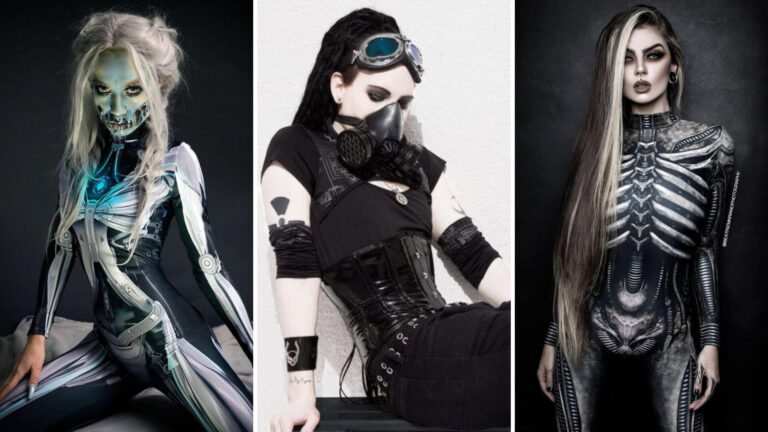
Cyber Goth, a unique substyle that merges gothic and cyberpunk cultures, creates a mesmerizing and futuristic fashion aesthetic. The standout feature of Cyber Goth fashion? Radiant fluorescent colors, boldly contrasting the traditional black palette synonymous with goth fashion. The use of synthetic materials like vinyl and rubber is also prevalent in Cyber Goth looks, giving them a sleek and futuristic edge.
Accessories play a key role in Cyber Goth fashion. LED circuit boards and cyberlox, which are synthetic hair falls often in bright and neon colors, are popular choices. These accessories add a high-tech and avant-garde element to the overall look.
To achieve the Cyber Goth aesthetic, bold and dramatic makeup is essential. This often includes heavy black eyeliner, dark and vibrant eyeshadow, and bold lip colors. Hairstyles are typically sleek and straight, often dyed in unconventional and vibrant hues.
Chunky and statement jewelry is another key aspect of Cyber Goth fashion. This can include oversized necklaces, spiked bracelets, and extravagant earrings.
The Cyber Goth look is created by blending dark gothic clothing with elements of cyberpunk fashion, such as pairing black corsets or leather jackets with neon-colored skirts or pants. The objective is to create an appearance that is unique, futuristic, and visually striking, reflecting the fusion of gothic and cyberpunk cultures.
Industrial Goth
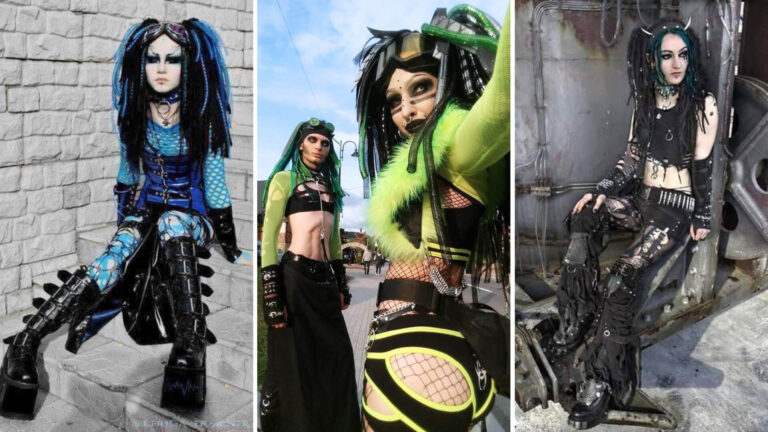
Industrial Goth is a substyle within the goth aesthetic that incorporates elements of rave-style fashion. This substyle is known for its bold and vibrant use of bright and neon shades in clothing, accessories, and hair.
Inspired by the iconic David Bowie, Industrial Goth embraces the use of fluorescent colors, whites, silvers, as well as synthetic materials like rubber and plastic. This fusion of elements creates a visually striking and futuristic look.
In terms of clothing, Industrial Goth often includes pieces with asymmetrical cuts, unconventional shapes, and exaggerated silhouettes. Neon-colored PVC and rubber garments, paired with metallic accents, are commonly seen in this substyle. Accessories also play a significant role, with neon arm cuffs, spiked collars, fishnet tights, and industrial-inspired jewelry adding an edgy touch.
When it comes to hair, Industrial Goth enthusiasts often opt for bold and statement-making styles. This can include brightly colored wigs, elaborate braids, or even shaved patterns adorned with neon hair extensions.
Nu Goth
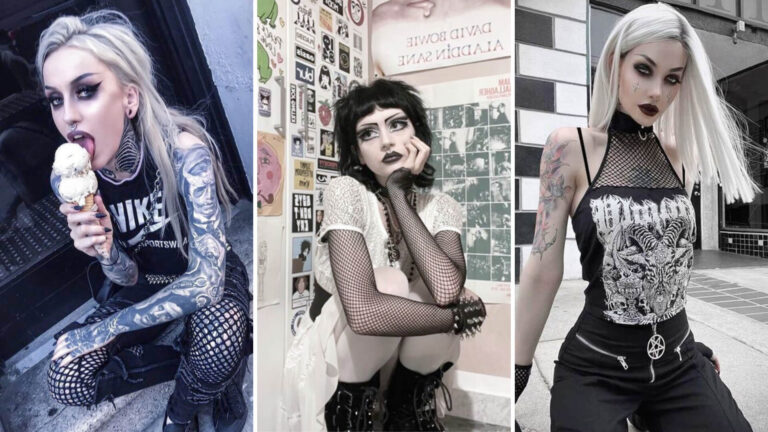
Nu Goth is a substyle within the goth aesthetic that emerged in the late 2000s. It is a modern take on traditional goth fashion with a distinct twist. Unlike traditional goth, which is often characterized by a darker and more monochromatic color palette, Nu Goth incorporates a wider range of colors and patterns.
The key elements that define Nu Goth include the use of dark, muted colors such as black, gray, and navy, combined with pops of bold and contrasting hues like burgundy, olive, or deep purple. This substyle also embraces elements of streetwear fashion, incorporating graphic tees, oversized hoodies, ripped jeans, and sportswear-inspired pieces.
In terms of makeup, Nu Goths often opt for a more minimalistic approach compared to traditional goths. Neutral and earthy tones are preferred, with focus on creating a flawless base, subtle contouring, and nude or matte lipstick. However, what sets Nu Goth apart is the incorporation of statement accessories like septum piercings, multiple ear piercings, and geometric or occult-inspired jewelry.
When it comes to hair, Nu Goth enthusiasts experiment with various styles, ranging from long and straight to messy and textured. Pastel and muted hair colors, such as lavender, dusty rose, or silver, are popular choices. Other notable characteristics include half-shaved heads, blunt bangs, and loose waves.
Pastel Goth
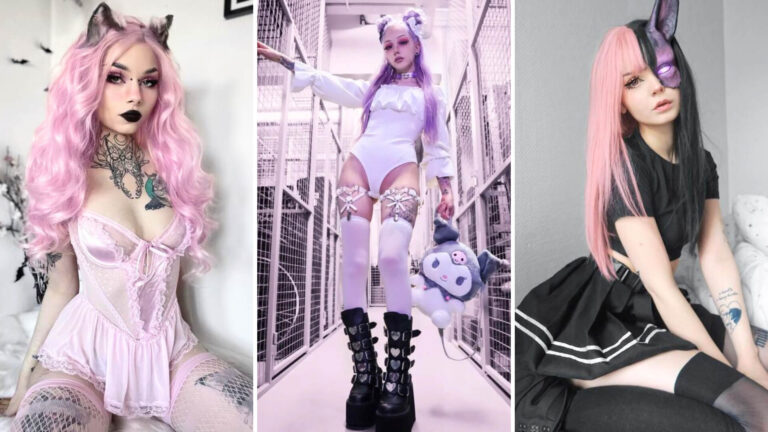
Pastel Goth is a subculture that emerged as a fusion of traditional goth aesthetics and softer, pastel colors. It is an alternative fashion and style movement that incorporates the dark elements of goth culture with a touch of lightness and whimsy.
Pastel Goth originated in the late 2000s and gained popularity through online platforms like Tumblr and Instagram. It borrows elements from traditional goth, such as the dark clothing, makeup, and accessories, but adds a twist by incorporating pastel colors into the mix. The pastel shades, such as baby pink, lavender, mint green, and light blue, give Pastel Goth its distinct and playful look.
In terms of fashion, Pastel Goths often wear black or dark clothing as a base, but then mix in pastel-colored pieces. This can include pastel-colored hair, sweaters, skirts, or accessories. Many Pastel Goths also incorporate elements of kawaii fashion, such as cute animal-themed accessories or characters.
One notable figure associated with Pastel Goth is singer-songwriter Melanie Martinez, who often incorporates pastel colors and dark themes in her music, fashion, and visuals. The aesthetic has also influenced newer aesthetics, such as the e-girl aesthetic, which incorporates elements of pastel colors and goth-inspired fashion.
Soft Goth
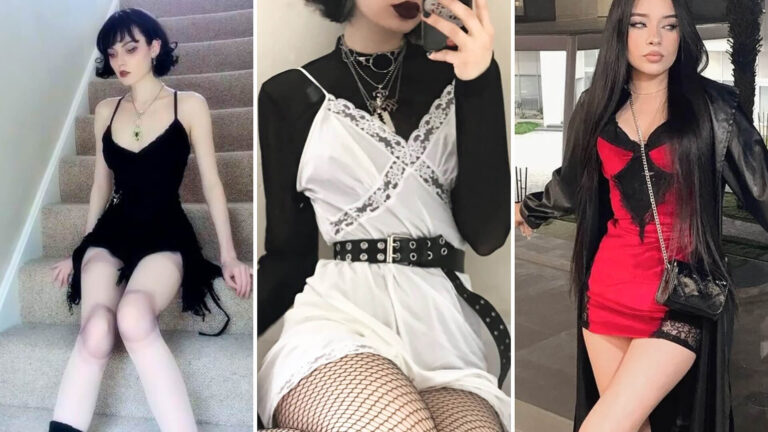
Soft Goth is a subculture that combines elements of traditional gothic fashion with a more relaxed and subtle aesthetic. This style embraces the dark and mysterious allure of goth while also incorporating whimsical and ethereal vibes.
In terms of fashion, Soft Goths often opt for flowy black dresses, adorned with intricate lace and velvet details. These clothing choices create an elegant and romantic silhouette that reflects the traditional gothic style. However, Soft Goths also introduce elements from other alternative styles, such as pastel colors and delicate accessories.
Unlike traditional gothic fashion, Soft Goth rejects the nihilistic and dark themes commonly associated with the subculture. Instead, this subculture focuses on creating a dreamy and mystical atmosphere. Soft Goths gravitate towards a more light-hearted and playful approach to their aesthetics, exploring the softer side of dark fashion.
Soft Goth has gained popularity for its ability to blend contrasting elements seamlessly, creating a distinctive and unique aesthetic. With their flowy black dresses, lace, velvet, and incorporation of pastel colors and alternative styles, Soft Goths carve out their own space within the gothic subculture, balancing darkness and softness to create an enchanting and ethereal appearance.
Victorian Goth
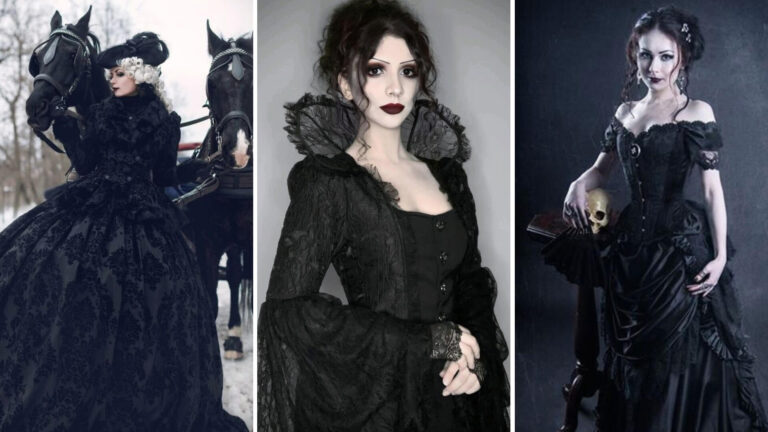
Victorian Goth is a captivating substyle of the goth aesthetic that draws inspiration from the Victorian era, known for its elegance and opulence. This subculture embraces a regal and sophisticated appearance, embracing the fashion and aesthetics of the past.
Victorian Goths are often seen donning long, flowing ballgowns in rich and dark colors, reminiscent of the Victorian era’s fashion. These dresses often feature intricate lace, ruffles, and velvet details, adding a touch of romanticism and femininity to their look. To accentuate their waistlines, Victorian Goths often opt for corset belts, creating a silhouette of elegance and grace.
Just like classic goth aesthetics, Victorian Goths incorporate certain elements to enhance their overall look. Their skin is often kept pale, giving a ghostly and ethereal appearance. Their eyes are adorned with smoky makeup, accentuating their allure and mystery. To further enhance their gothic appeal, Victorian Goths often sport long, flowing hair, adding a touch of drama and elegance to their look.
In essence, Victorian Goth fashion merges the elegance and grandeur of the Victorian era with the dark and mysterious elements of gothic fashion. Through their choice of clothing and makeup, Victorian Goths craft an aesthetic that exudes both a timeless beauty and a haunting allure, embracing the elegance and royalty associated with the Victorian era.
Vampire Goth
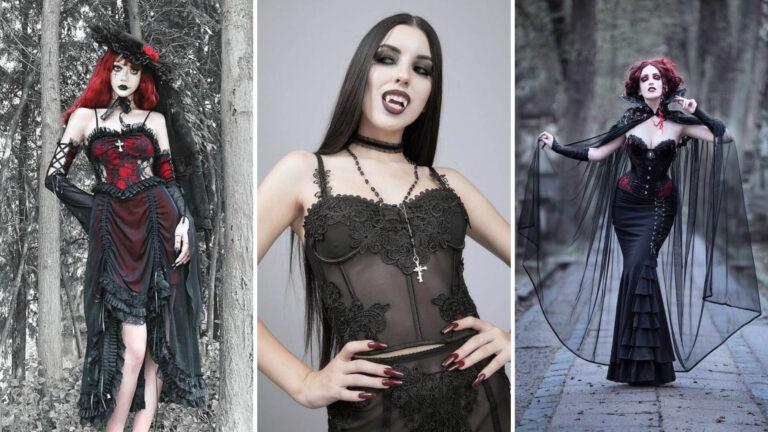
The Vampire Goth sub-style is a captivating blend of Romantic Goth aesthetics and the allure of vampire lore. Influenced by the Victorian era’s fashion, Vampire Goths embrace dark and mysterious pieces to create an enchanting and haunting appearance. This sub-style often emphasizes a pale complexion, reminiscent of the undead.
When it comes to fashion, Vampire Goths opt for garments that embody the elegance and drama of the Victorian era. They are often spotted in billowing capes, ruffled shirts, and corseted dresses in deep, rich hues. Lace details, velvet fabrics, and brocade patterns add a touch of opulence to their outfits, evoking a sense of romance and darkness.
Makeup plays a crucial role in achieving the Vampire Goth aesthetic. The eyes take center stage with smoky eyeshadow and dark eyeliner, enhancing their mysterious allure. Pale foundation is used to create a ghostly complexion, and deep red or black lipstick is often applied to create a stark contrast.
Vampire Goths also have the option to further immerse themselves in the vampire persona by accessorizing with fake vampire fangs or wearing red contact lenses, intensifying their supernatural appearance.
Hippie Goth
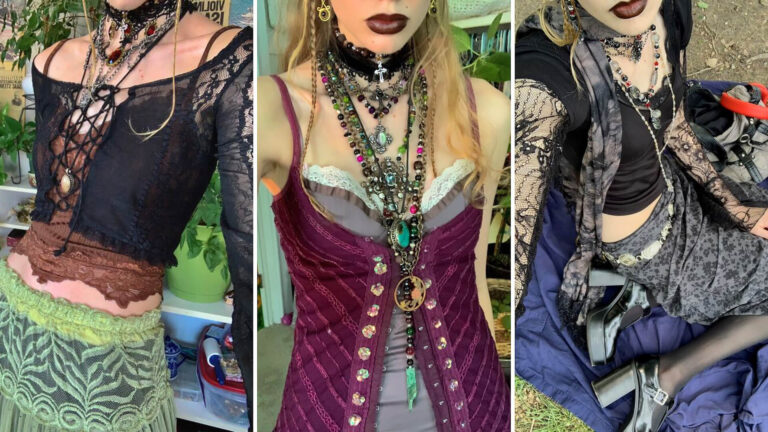
Hippie Goth is a unique fusion of the dark and dramatic elements of gothic fashion with the free-spirited and bohemian vibe of hippie culture. It’s a subculture that embraces both the darkness of the goth aesthetic and the peace and love ethos of the hippie movement.
Hippie Goths are known to be eco-friendly and animal lovers, often practicing sustainable living and showing a deep interest in the occult. Their fashion choices reflect this blend of styles, with a focus on earthy colors and natural materials.
The Hippie Goth look incorporates elements of both gothic and bohemian fashion. Dark makeup is a key component, with smoky eyes using deep, rich hues and heavy eyeliner to add a touch of mystery. They may also opt for a pale complexion, reminiscent of the gothic aesthetic.
Accessories play a significant role in the Hippie Goth style. Think chunky jewelry made from natural materials like wood or bone, along with mystical symbols and crystals. Hairstyles can range from long and flowy waves to braids adorned with flowers or feathers.
Clothing choices for the Hippie Goth often include flowing, layered dresses or skirts in dark colors, combined with bohemian-inspired patterns like paisley or floral. They may also incorporate elements of gothic fashion such as lace or velvet.
Bubble Goth
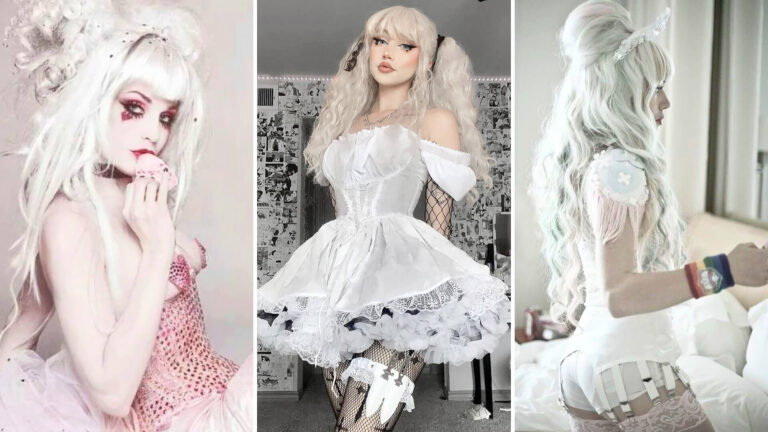
Bubble Goth is a newer subcategory of goth that originated from the creative vision of Estonian pop singer Kerli Koiv. Embracing a unique blend of beauty and creepiness, Bubble Goth challenges traditional gothic aesthetics.
Bubble Goth is characterized by its contrasting blend of light and dark elements. Pastel pink, blue, white, and silver are commonly used colors, which create a softer and more whimsical vibe compared to traditional gothic fashion.
In terms of fashion choices, Bubble Goths often opt for short skirts paired with tops that feature cute and edgy details. The incorporation of gasmasks is also a distinctive feature that adds an element of mystery and intrigue.
Hairstyles in Bubble Goth often involve white, silver, or soft pink hues, complementing the overall pastel color scheme. This complements the soft touch of Bubble Goth, creating a dreamlike and ethereal atmosphere.
With its fusion of darkness and lightness, Bubble Goth offers a fresh take on gothic fashion, influenced by the creative mind of Kerli Koiv. It has gained popularity among those who seek to express their individuality through a unique and unconventional aesthetic.
Goth Aesthetic Fashion and Outfits Guide
Gothic fashion has long been associated with dark and dramatic attire, drawing inspiration from subcultures and music scenes that emerged in the late 1970s. The goth aesthetic is characterized by its dark, moody, and sometimes macabre themes, reflecting an appreciation for the darker side of life.
From black clothing to heavy makeup and distinctive accessories, goth fashion stands out for its unique blend of edginess and elegance. In this guide, we will delve into the different elements of goth fashion, including clothing choices, makeup styles, and accessories, to help you embrace and express your own personal goth style.
Goth Clothing
Goth clothing encompasses a wide range of styles, each with its own unique elements that contribute to the overall goth aesthetic. Corsets are a staple in gothic fashion, accentuating the curves and creating a dramatic silhouette. Petticoats add volume and femininity to dresses and skirts, while trench coats give a mysterious and timeless vibe to any outfit. Platform boots are a popular choice for footwear, providing both height and an edgy look.
Lace accents are often seen in goth clothing, adding a touch of delicacy and elegance. The combination of these elements creates a dark yet glamorous aesthetic that is synonymous with gothic fashion.
Several designers have embraced the goth trend, producing collections that highlight the beauty of this style. Brands such as Alexander McQueen, Vivienne Westwood, and Jean Paul Gaultier have created stunning goth-inspired pieces. Their designs often incorporate intricate details, dark color palettes, and a sense of romance.
In conclusion, goth clothes encompasses a variety of elements like corsets, petticoats, trench coats, platform boots, and lace accents. These elements contribute to the goth aesthetic, creating an edgy and glamorous look. Various designers have embraced this trend and created stunning goth-inspired collections.
You can find more Goth clothing and accessories in our Goth Outfits Collection.
Try our new Aesthetic Outfits AI to Try-on Clothes.
Goth Accessories
Goth accessories are essential elements of the goth aesthetic, adding the perfect finishing touches to a goth-inspired look. These accessories range from subtle details to bold and dramatic pieces, allowing individuals to express their unique style within the goth subculture.
One popular goth accessory is the black hat, which adds a touch of mystery and sophistication to any outfit. Whether it’s a wide-brimmed hat or a sleek fedora, black hats are a staple in the goth fashion scene.
Chokers are another iconic goth accessory that instantly elevates any look. These close-fitting necklaces draw attention to the neckline and provide a sense of edginess. From simple black velvet chokers to more elaborate styles adorned with skulls or spikes, chokers are a must-have for any goth enthusiast.
Fishnet or lace tights are often paired with goth outfits to create a striking visual effect. These textured stockings add a layer of complexity to the overall ensemble, giving the appearance of intricate detailing on the skin.
To complete the goth look, silver or black earrings are commonly worn. These earrings can range from small and dainty studs to larger and more elaborate designs, such as crosses, bats, or skulls. They add a touch of darkness and individuality to the overall aesthetic.
Goth Makeup
Goth makeup is an essential element of the gothic aesthetic, adding depth and intensity to the overall look. Key elements of goth makeup include dark eyeliner and smokey eyes, which create a dramatic and mysterious effect.
When it comes to eyeliner, black is the predominant shade used by goths. Whether applied along the lash line or in a more dramatic winged style, dark eyeliner defines and enhances the eyes, giving them a captivating intensity. Additionally, goth makeup often incorporates mystical signs and runes drawn with eyeliner, adding an enchanting and occult touch.
For smokey eyes, goths typically use dark shades of eyeshadow, such as deep purples, blues, or blacks. This technique involves blending multiple shades together to create a soft, smudged effect around the eyes. The result is a striking and alluring gaze that perfectly complements the gothic aesthetic.
However, it is important to strike a balance and avoid overdoing the goth makeup look. Too much heavy eyeliner or excessive layers of eyeshadow can overshadow other elements of the overall gothic style. The goal is to create a balanced and cohesive look that embraces the darkness and mystery while still allowing the individual to shine.
Goth Hairstyles
Goth hairstyles play a vital role in completing the overall gothic aesthetic. Often characterized by dark and edgy styles, these hairstyles perfectly complement the goth fashion and subculture. Black hair is the most common choice for goths, as it represents the essence of the dark and mysterious theme.
However, for those seeking a softer and more romantic look, partial coloring in dark shades of other colors can be incorporated into goth hairstyles. Deep purples, blues, or even burgundy can add a touch of individuality and creativity to the overall look, while still maintaining the gothic vibe.
For individuals who do not want to permanently dye or bleach their hair, alternative options are available. Split coloring, where the hair is divided into sections and different colors are applied, is a popular trend among goth enthusiasts. Wigs are also a great option, allowing for quick and temporary changes to reflect different moods or styles.
To further enhance the goth aesthetic, various hair accessories can be utilized. From intricate headbands and hair chains to elegant barrettes or hair combs adorned with dark gemstones or symbols, these accessories can add an extra layer of enchantment to goth hairstyles.
Tips on How to Create Your Goth Outfit
Looking to create a goth outfit that embodies the dark and edgy goth aesthetic? Look no further. With inspiration from fashion influencers like Billie Eilish and Lori Harvey, here are some key tips and guidelines to help you create the perfect goth ensemble.
- First and foremost, goth style clothes and accessories are essential. Think corsets and petticoats, platform boots, and anything black. Dark colors are a staple in goth fashion, so opt for deep shades like black, burgundy, or dark purple. Incorporating edgy details like spikes or studs can add that extra touch of attitude.
- Layering is key when it comes to goth outfits. Mix different textures such as lace, leather, and fishnet to add depth and dimension. Play around with proportions, pairing oversized tops with fitted bottoms or vice versa. Don’t be afraid to experiment and find what works best for you.
- Lastly, accessorize to complete the goth aesthetic. Stock up on chokers, crucifix jewelry, and statement rings. Fishnet gloves and fingerless gloves are great for adding an edgy vibe. And, of course, don’t forget the dark and smoky makeup to complete your goth look.
By incorporating these key elements, you’ll be well on your way to creating a killer goth outfit that embodies the goth aesthetic. So, embrace your dark side and let your goth style shine.
Impact of Goth Aesthetic on Fashion
The goth aesthetic has had a significant impact on the world of fashion, influencing and shaping various styles and trends. With its dark and rebellious undertones, the goth aesthetic has challenged the norms of traditional fashion and introduced a new wave of style that embraces the unconventional and the macabre.
From gothic fashion subcultures to mainstream runway shows, the impact of goth aesthetics can be seen in the incorporation of dark clothing, heavy makeup, and eccentric accessories. The influence of goth has even extended beyond just clothing, with its impact evident in other areas such as music, art, and even lifestyle choices.
As a result, the goth aesthetic has emerged as a powerful and enduring force in the world of fashion, bringing a sense of intrigue, mystery, and individuality to those who embrace it.
Goth Aesthetic in Art and Pop Culture
Goth Aesthetic holds a significant impact in both the art and pop culture realms. It has heavily influenced fashion trends, mainstream media, and renowned designers like John Galliano and Vivienne Westwood. This dark, mysterious, and often unconventional style emerged in the late 1970s and has continued to shape the fashion industry ever since.
The goth subculture has slowly gained broader acceptance in society, leading to increased incorporation of goth-inspired designs in collections. John Galliano, the legendary fashion designer, has drawn inspiration from gothic elements in his creations. His avant-garde shows often feature elements like dark clothing, heavy makeup, and chunky boots—a clear nod to the goth aesthetic.
Vivienne Westwood, another iconic designer, has also been influenced by the goth subculture. Her designs frequently incorporate dark colors, deconstructed silhouettes, and unconventional materials, reflecting the goth aesthetic’s influence on her work.
Notable pop culture icons have embraced the goth aesthetic, further popularizing it. From musicians like Joy Division and goth bands of the ’80s to actors like Tim Burton and musicians within the industrial and electronic music scenes, the goth aesthetic has permeated various art forms.
With its bold and dark imagery, the goth aesthetic has left an indelible mark on art and pop culture. As the lines between subcultures and mainstream fashion continue to blur, the goth aesthetic remains an enduring and influential force in the fashion industry and beyond.
Late 70s Punk Influence on Gothic Fashion
The goth aesthetic, which emerged in the late 1970s, was influenced by the punk subculture of the time. It drew inspiration from punk’s rebelliousness and DIY attitude, resulting in a unique and captivating fashion style.
Punk subculture was characterized by its anti-establishment attitude and emphasis on self-expression, which resonated with those seeking a darker and more mysterious alternative. With punk’s influence, gothic fashion began to take shape, combining elements of punk’s rebellious style with a more melancholic and romantic aesthetic.
Key punk fashion elements became central to the goth style. Torn clothing, symbolizing the rejection of conventional norms, became a hallmark of goth fashion. Dark and heavy makeup, inspired by punk’s bold and confrontational approach, became a means of self-expression for goths. Fishnet stockings and rebellious hairstyles, such as mohawks and shaved heads, were also borrowed from punk.
The late 70s punk movement laid the groundwork for the goth aesthetic, influencing goth fashion with its DIY ethos, raw style, and rejection of societal norms. This fusion of punk and goth elements created a unique and captivating fashion style that has continued to evolve and inspire to this day.
Goth Aesthetic in Music & Entertainment
The goth aesthetic extends beyond fashion and permeates into the realms of music and entertainment. With its origins in the late 1970s, the goth subculture thrived alongside the rise of punk, creating its own unique sounds and styles that continue to influence artists to this day.
Goth music, often characterized by melancholic lyrics, atmospheric instrumentation, and haunting vocals, has a signature sound that ranges from gothic rock to ethereal wave. Bands like Joy Division, Bauhaus, and Siouxsie and the Banshees set the foundation for the genre, while contemporary acts like Chelsea Wolfe and Drab Majesty continue the tradition with their own twists. In the realm of entertainment, goth aesthetics can be seen in films, literature, and art that explore darker themes and evoke a sense of mystery and romance.
From Edgar Allan Poe’s chilling tales to Tim Burton’s visually distinctive films, the goth aesthetic provides a captivating and thought-provoking perspective in the world of music and entertainment.
Goth Aesthetic in Art and Design
The goth aesthetic has made a profound impact on the world of art and design, influencing various mediums and design trends. It is characterized by its dark and macabre themes, use of black and monochromatic colors, and the inclusion of gothic symbols and motifs.
In art, the goth aesthetic has been embraced by artists who seek to explore the darker aspects of human emotion and experience. It has influenced artistic movements such as Gothic art and Romanticism, which both embrace themes of death, decay, and the supernatural. Gothic art often features images of haunted landscapes, abandoned castles, and morbid symbolism, while Romanticism focuses on the individual’s inner turmoil and existential angst.
In design, the goth aesthetic has shaped trends such as minimalist and industrial design. The use of black and monochromatic colors creates a sense of mystery and elegance, while gothic symbols like crosses, skulls, and ravens add an element of gothic flair. This aesthetic can be seen in fashion, interior design, and graphic design, where it creates a sense of edginess and sophistication.
Goth Aesthetic in Movies and Cinematography
The goth aesthetic has greatly influenced the world of movies and cinematography, adding a sense of darkness, mystery, and romance to the silver screen. One key example of the goth aesthetic in film is Tim Burton’s works, such as “Edward Scissorhands” and “The Nightmare Before Christmas.” These films are known for their dark and atmospheric visuals, gothic-inspired fashion, and macabre storylines.
Incorporating gothic elements and imagery, these films create a world that is both hauntingly beautiful and emotionally engaging. The use of dark and moody visuals, often set against Gothic backdrops like graveyards and dilapidated mansions, adds a sense of foreboding and intrigue. Characters are often portrayed with goth-inspired fashion, showcasing dark clothing, heavy makeup, and unique hair styles.
The goth aesthetic in cinematography enhances the overall mood and tone of the films. It creates an otherworldly atmosphere that transports viewers into a realm filled with darkness and introspection. The use of contrasting colors, such as deep shades of black and vibrant pops of red, adds to the visual impact and heightens the emotional intensity of the storytelling.
The Goth Style in Interior Design
The Goth aesthetic extends beyond film and fashion and has also found its place in the world of interior design. This unique style embraces the dark and macabre, creating a captivating and mysterious atmosphere within living spaces.
Gothic architecture heavily influences this aesthetic, with its signature pointed arches, intricate details, and skeletal appearance. These stylistic elements can be seen in the design of Gothic-inspired furniture and decor.
Dark colors play a significant role in Goth interior design, with deep shades of black, rich purples, and velvety reds dominating the color palette. This creates a sense of drama and opulence.
Antique furniture is a common feature in Goth-inspired interiors, with ornate carvings and dark stained wood adding to the overall gothic ambience. Candelabras and chandeliers provide atmospheric lighting, casting flickering shadows on the walls.
To fully embrace the Goth aesthetic, occult symbols and imagery are often incorporated into the design. This can include motifs like pentagrams, skulls, and other mystical elements.
Future of Goth Aesthetic Beyond 2024
The future of the goth aesthetic beyond 2024 is likely to see further evolution and the merging of influences from various subcultures. As society becomes more interconnected, goth subcultures will continue to interact with and be influenced by different genres, styles, and art forms. This cross-pollination will lead to the creation of new and unique manifestations of the goth aesthetic.
Technology will also play a significant role in shaping the future of goth fashion, music, art, and pop culture. The rise of internet culture and social media platforms allows goth enthusiasts to connect and share their interests with a global audience. Online communities and virtual spaces provide opportunities for creative expression and collaboration within the goth subcultures.
Mainstream acceptance of the goth aesthetic will further fuel its future development. As goth aesthetics continue to gain recognition and appreciation, they will likely become more accessible and diverse. This acceptance may lead to a wider range of goth-inspired fashion lines, music genres, and art forms.
Overall, the future of the goth aesthetic is likely to be dynamic and innovative, with evolving trends and a continued merging of influences. As technology and mainstream acceptance continue to shape the cultural landscape, goth subcultures will adapt, grow, and create new expressions of the goth aesthetic.
